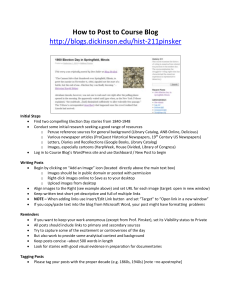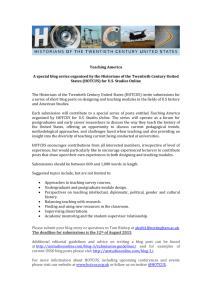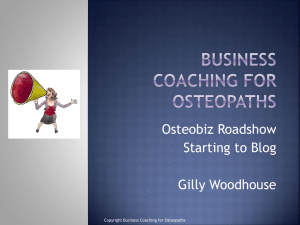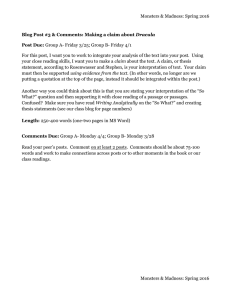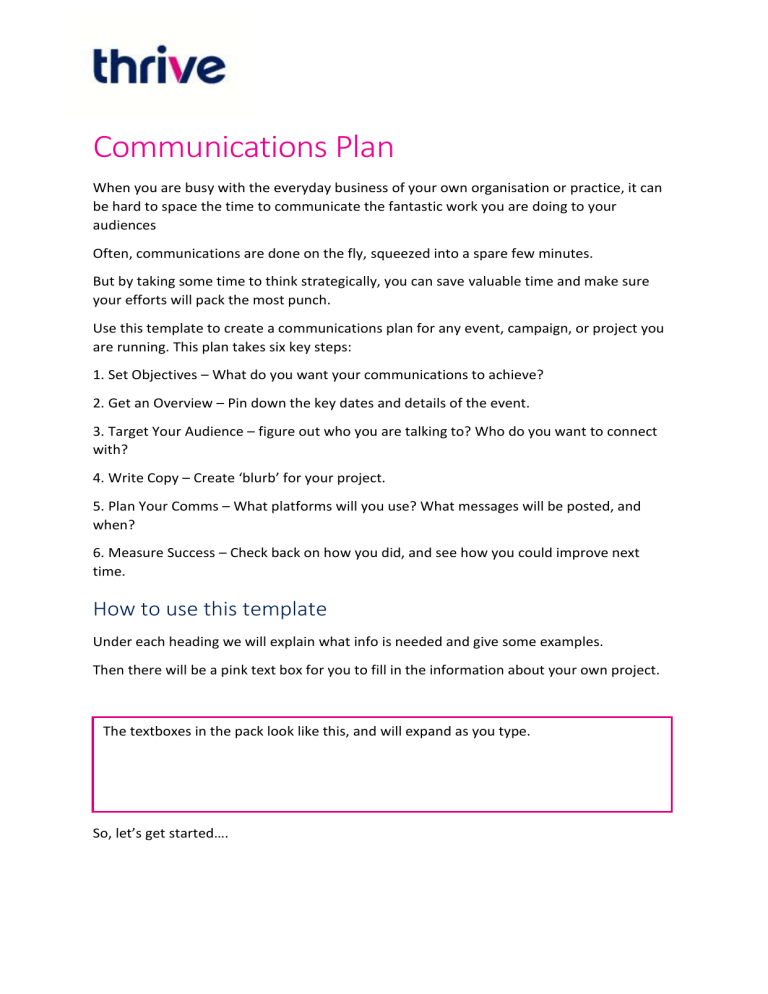
Communications Plan When you are busy with the everyday business of your own organisation or practice, it can be hard to space the time to communicate the fantastic work you are doing to your audiences Often, communications are done on the fly, squeezed into a spare few minutes. But by taking some time to think strategically, you can save valuable time and make sure your efforts will pack the most punch. Use this template to create a communications plan for any event, campaign, or project you are running. This plan takes six key steps: 1. Set Objectives – What do you want your communications to achieve? 2. Get an Overview – Pin down the key dates and details of the event. 3. Target Your Audience – figure out who you are talking to? Who do you want to connect with? 4. Write Copy – Create ‘blurb’ for your project. 5. Plan Your Comms – What platforms will you use? What messages will be posted, and when? 6. Measure Success – Check back on how you did, and see how you could improve next time. How to use this template Under each heading we will explain what info is needed and give some examples. Then there will be a pink text box for you to fill in the information about your own project. The textboxes in the pack look like this, and will expand as you type. So, let’s get started…. Step One – Set Objectives Before putting pen to paper, take some time to figure out what you want to achieve. Think about the broader objectives of your organisation. How does this communications plan sit within this? Is it a year-long overall plan, or project-specific? Then look at how you’ve done with previous campaigns or projects and you can begin to see realistic targets for success. If you don’t know how you are doing at the moment, do a little research to establish your starting point. Do you want an event fully signed up? An increase in season ticket holders? By how much? If you are promoting your gallery’s tour programme, what does success look like? How many visitors per month take a tour now? How much do you want to increase it by? Objectives Step Two – Overview of Key Details Short description of project(s) or event(s). This is useful to keep information consistent across your whole team. List the important details: key dates, times, venue, price etc. Key Details Step Three - Target Market It’s easy to say your target market is ‘everyone’, but this won’t get you the results you want. Some audiences will respond to pieces that are challenging, some will not. Others might respond to light funny work, others might not. Think about who is most likely to buy a ticket or visit your venue? Can you come up with a persona for them? So, if you are putting on a theatre show for children, target markets might be; families with children aged 4-8, Schools, Nursery Schools, SureStart/Family Support Groups, after school clubs especially drama or speech and drama, private drama schools, etc. Target Markets Key messages Once you have your target markets identified, think about the best ways to communicate with them. For example: Target Market Key Messages Communications Method Families Weekly Sunday workshops suitable for children of all ages – bring your big kids and little kids too. PR, website, social media, event listings, targeted email campaign, monthly newsletter (your organisation or relevant organisations you can ask to share your news/events), networking, etc. Our gallery is family-friendly - with easy and free parking outside the front door, baby changing facilities and is a breastfeeding welcome venue. Key Messages Target Audience Key Messages Communications Method Step Four - Marketing Copy Writing copy can be hard. But clear your diary for a few hours and concentrate. Once it is done, it is done and you won’t have to panic when someone asks you for a ‘blurb’. Try to keep your copy clear, free of jargon, with one simple message. Say the most important things first. Could include: Short description (20 words) i.e. how you talk about it in person/by email Longer (100 words) description for brochures, press releases, web. Should detail any relevant credits that need to be included in communications e.g. project partners, funders, sponsors, etc. Marketing Copy Step Five - Communications Plan It’s not necessary to use every communications platform just because you can. Here is a list of the most popular platforms, and some things you might do with them. Select the platforms that you have enough time to properly run, and more importantly, that will reach your target market. Print Flyer Postcards Posters Programmes Information leaflets to be handed out at events or exhibitions Feedback postcards Social media/photo props to encourage visitors to share their visit on social media Print Communications Digital Content Opportunities/requirements for photo, video or podcast content - include dates, timescales and who has responsibility. Photos that can be used in promotional activity (website, social media or email campaigns) Photos that can be used to promote similar events in future to create a photo bank Promotional videos (pre or post project/event) – can be used for sales or to report to funders Social media content during a project/event e.g. Instagram Stories, Facebook Live, Twitter Gallery tours, etc. Identify opportunities to create blog posts, short interviews, guest reviewers or vox pops with those involved and/or your customers Digital Content Website & Blog Overview of content, how/where it will be used and dates/timescales. News story Event Blog post Website & Blog Email Campaigns List any email campaigns with the following information for each: Target Audience Date to be sent Brief overview of email content Email Campaigns Social Media Overview of social media opportunities and ideas. Ideally you will have a separate (detailed) social media plan. Include key messages, key dates and responsibilities. Social Media Other Orgs & Listings Add an overview of opportunities, if relevant, to share information through other organisations via a new story, emails and social media e.g. Free listing or event promotion opportunities Supporters & Partners e.g. artists involved, family groups, bloggers, etc. Local and tourism organisations and listings. Other Orgs & Listings PR Overview of any PR angles and opportunities. Include dates/timescales and who you want to be involved e.g. artist, producer, key staff, those taking part in the project, etc. TV Radio Newspaper e.g. listings, feature pieces (if there’s a link between your event, show or workshop which fits a features column) PR Step Six - Measuring Success and Refine Identify what content is working, what isn’t and how this shapes what you do in future - by focusing on what works best. Look back at the objectives you set in step one – were these achieved? Below are some measures you could use to track your communications effectiveness. Email Mailings no. of sign ups email open rate link clicks shares Website (Google Analytics) No. of visitors (unique vs total no. of views) most popular pages dwell time Site traffic acquisition i.e. how are people coming to the site. o organic searches o Through activity on your social media or blog driving people back to the website o Referrals - can you identify any significant referral sites that you can establish a relationship with. Blog No. of Followers No. of posts No. of views (total and by post) No. of likes and comments (by post) Twitter Followers No. of Tweets Tweet impressions Profile visits Mentions Top 5 performing tweets – what type of content was it Facebook Likes No. of Posts Page views and likes Post activity - likes, shares & comments Top 5 performing posts - what type of content was it LinkedIn If staff are on LinkedIn to network on behalf of your organisation, ask them to share details about posts they made relating to the campaign and any associated activity or new contacts made. Instagram Impressions Reach Example Communications Report: Platform Facebook Mailchimp newsletter Measure 10 shares on three posts about event 100 sent out, 30% opened Notes Usual performance 40% opened for last event – try sending emails out earlier in the week, rather than Friday evening. Communications Report Platform Measure Notes Objectives Achieved: Changes for Future Campaigns: For more practical resources visit: www.wewillthrive.co.uk

